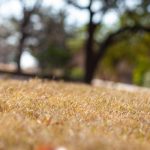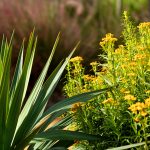Engelmann’s daisy may blend in with the other yellow wildflowers along the roadside. But get to know this cheerful native perennial and you’ll find it has many attributes that set it apart from the crowd!
During the spring, San Antonio roadsides, fields and the yards of gardeners in the know are filled with a profusion of wildflowers.
There are several species that produce similar cheerful yellow flowers. In fact, so many are so similar that many people find it difficult to distinguish between them. It can be rather daunting for the causal botanist trying to sort through the chaos. A good place to start is with one of the easiest to distinguish from the rest: Engelmann’s daisy.
This long-lived, drought tolerant, and interesting native perennial is one of my favorite spring bloomers and I have several in my yard. The bright yellow flowers look similar to the other yellow composites that bloom from early spring to early summer. Also, the flowers are a favorite of the pollinators that are active during that time and the seeds are utilized by a wide range of birds.

Sometimes, if the weather is right, Engelmann’s daisy reprises its spring performance in the fall or winter as well. What most sets them apart from the others is their distinctive leaves — dark green with a white mid-vein and very deeply lobed. This is why its other common name is cut-leaf daisy. The leaves appear as a rosette in the fall and last all winter. Look for these distinctive leaves the next time you take a nature walk.
Engelmann’s daisy occurs all over Texas, except in the eastern forests, all the way up to Nebraska. Its ubiquitous presence and importance as forage for cattle lead led Ricky Linex to dub Engelmann’s daisy one of Texas’ “Big Four Forbs” in his book Range Plants of North Texas. The reason for its success? A giant tap root that can reach several feet into the ground and grows to be several inches wide.
With this root Engelmann’s daisy can take advantage of water out of reach for many plants — it is known for blooming in times too dry for other plants. Engelmann’s daisy also tolerates mowing during the summer, which is why it persists along roads so well. My Engelmann’s daisies grow together with my buffalo grass lawn; once they’re done seeding, I mow them back and let the buffalo grass take over for the summer.
This cheerful perennial may blend in with the other yellow wildflowers on the roadside. But get to know this stalwart plant and you’ll find it has many attributes that set it apart from the crowd! Dependable flowers, many wildlife benefits and the link to Texas pride and rangelands, what’s not to like?




